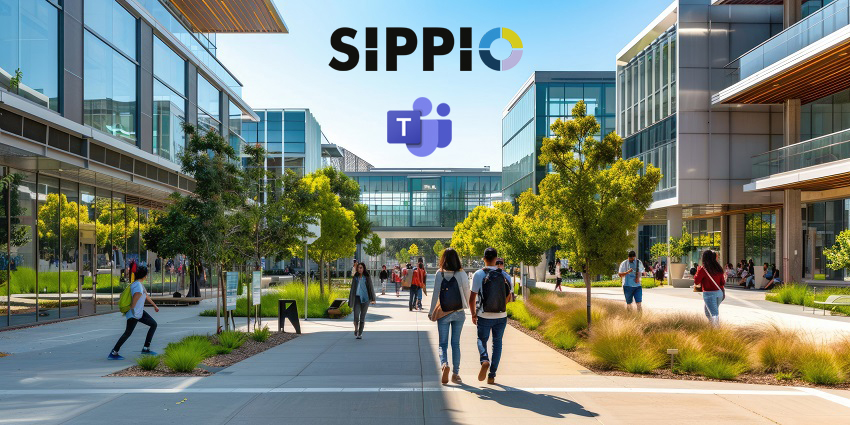As the digital transformation era starts to count itself in decades rather than years, higher education institutions are rethinking their communication strategies to enhance efficiency, reduce costs, and support a more connected learning environment.
Microsoft Teams is emerging as a powerful solution for universities looking to consolidate their communication tools while improving user experiences. By integrating voice, messaging, and collaboration tools into a single platform, Teams provides a seamless and cost-effective approach that aligns with modern digital workflows.
From reducing IT complexity to fostering mobility and digital communication synergy, Microsoft Teams, powered by SIPPIO, is reshaping the way universities communicate, ensuring students and faculty stay connected wherever they are.
Lower UC Costs and Improved User Experiences
Traditional telephony and legacy UC infrastructures have been expensive and cumbersome for decades, demanding extensive on-prem hardware and ongoing maintenance. Microsoft Teams Phone offers institutions a chance to transition to a cloud-based solution that significantly reduces costs while offering an intuitive and efficient communication platform that refines the user experience.
For example, through SIPPIO, Roseman University migrated from a legacy Cisco UCM system to Microsoft Teams, skirting the necessity for costly on-prem infrastructure. The university dramatically lowered its phone system expenses by utilising Microsoft’s education licensing.
Additionally, the shift culminated in an improved UE, as faculty and staff quickly adapted to the modern communication interface. While the move to a softphone-centric approach was initially greeted with scepticism by faculty accustomed to desk phones, after a 90-day trial, the vast majority of users found the transition to Teams seamless, with only 50 of 700 users electing to return to their desk phones.
This eliminated the university’s need for most physical handsets.
By consolidating multiple comms tools into a single application, universities minimise IT complexity and bolster productivity. With voice becoming an integrated capability rather than a siloed system, faculty and students reap the benefits of a more streamlined process, enabling efficient communication across campuses.
Enhanced Digital Communication Synergy
Today’s students and faculty communicate via a diversity of digital channels, and Microsoft Teams is facilitating universities’ fusion of those strategies into a cohesive communication ecosystem. While voice remains pivotal, higher ed institutions are recognising that modern communication increasingly begins digitally—via email, text messaging, or instant chat—before escalating into a call or video meeting.
Microsoft Teams Phone by SIPPIO empowers institutions to elevate communication beyond traditional voice services by merging SMS, WhatsApp, and Apple Messages into the platform. This fosters a smooth, omnichannel experience for faculty and students, encouraging them to connect via their digital outlet of choice. Rather than depending exclusively on contact centres for student inquiries, Teams allows direct and straightforward contact between faculty and students, which in turn, boosts engagement and responsiveness.
Critically, the benefits of this integration extend well beyond convenience. By centralising comms channels within Teams, universities can get rid of redundant tools, lowering licensing costs as well as IT overhead.
Just as importantly, faculty and staff can oversee all interactions in one app, refining efficiency and ensuring prompt replies to student messages. This strategy not only modernises communication strategies but also builds a more inclusive and responsive environment for all.
Improved Mobility for a Modern Learning Environment
Higher ed is no longer restricted to traditional lecture halls or conventional office spaces. As institutions thrive via the new era of remote learning and hybrid work environments, mobility has become an absolutely essential factor in maintaining seamless communication. Microsoft Teams assists with this revolution by allowing faculty and students to stay connected anytime, anywhere, through their mobile devices.
Roseman University’s experience with Teams by SIPPIO illustrates the transition to a mobile-first approach. Faculty members rapidly adapted to using Teams on their smartphones, meaning they could stay accessible without being tethered to an old-school desk phone.
The next stage in this mobility evolution is fixed-mobile convergence (FMC), which allows a single phone number to function viably across mobile and Teams contexts. This landmark feature addresses the requirement for multiple contact numbers and allows faculty and staff to make and receive calls via their official university line, regardless of their location.
Convenience isn’t the only major boon. FMC boosts call reliability by allowing elegant transitions between Wi-Fi and cellular networks, dramatically reducing dropped calls while refining call quality. It also reinforces security and privacy by stopping faculty from accidentally sharing personal info.
With Teams’ mobile capabilities, universities can cultivate a more flexible and mobile academic universe.
How SIPPIO Supports Higher Education Institutions
SIPPIO performs an invaluable role in supporting Microsoft Teams’ capabilities for higher ed institutions by delivering end-to-end comms offerings specifically tailored to academic environments. Universities seeking cost efficiency and a streamlined user experience can leverage SIPPIO’s offerings to optimise their communications infrastructure.
SIPPIO offers external calling services, meaning institutions can replace pricey legacy telephony systems with a fully integrated cloud solution. Additionally, SIPPIO Text Messaging by ClerkChat ensures that faculty and students can engage seamlessly via SMS and other digital comms channels within Teams, offsetting the need for third-party messaging apps. This not only improves accessibility but helps maintain compliance and security standards.
Moreover, SIPPIO Mobile by Tango Networks includes FMC, so faculty and staff can use a single number across all their devices. This disrupts the challenges associated with overseeing multiple contact numbers and makes communication more reliable via carrier-grade voice-over LTE and 5G networks.
By integrating SIPPIO’s offerings, higher ed institutions can enjoy the benefits of Microsoft Teams while reducing costs, bolstering digital communications, and boosting mobility—all while ensuring a smooth and hyper-modern comms experience for students, faculty, and administrators.
- SIPPIO, Mutare Partner To Bolster Voice Traffic Security
- SIPPIO Empowers Microsoft Teams Phone MSPs, Resellers With Partner Exchange#
__________________________________________________________________________________________________________________________________________________________________________________
Don’t Get Left Behind in the Cloud Revolution!
The future of cloud communications is here—are you ready?
Join UC Today’s Kieran Devlin and SIPPIO’s Steve Forcum as they unpack the strategies that will define success in 2025 and beyond. Whether you’re a UC reseller, service provider, or enterprise leader, this conversation is packed with insights on market shifts, cost savings, AI innovation, and new opportunities in the Operator Connect Marketplace.
- Discover how to reduce TCO by nearly 40%
- Leverage AI to enhance productivity
- Seize the down-market opportunity before competitors do
Don’t miss out—learn how to simplify UC integration and future-proof your business today!
Watch our recent discussion here.







